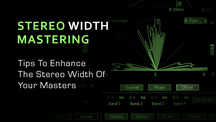Well-balanced, creative use of the full stereo field can, in a lot of cases, be the thing that separates a decent sounding demo from a proper ‘pro’ tune.
Not only will it improve the experience for your listener but can help add clarity and space to your productions. However, making something sound ‘wide’ isn’t always a simple as a bit of left and right panning. Learn how to get a wider mix with these stereo width mastering tips.
1. Resolve Frequency Conflicts
When more than one musical sound is playing simultaneously, there’ll usually be a degree of frequency masking. For example, the addition of a guitar part playing in a similar pitch range to a piano part will likely obstruct some of the frequencies of the piano, making it more difficult to hear. Panning is possibly the simplest solution for reducing the effects of frequency masking, but more advanced methods of altering stereo placement will also work well to overcome frequency conflicts.
2. Fix your acoustics
A poor listening environment will only hinder your ability to make reliable judgements and important decisions when it comes to the stereo field (and anything else!). Listening on the best speakers you can get hold of is a good start, but the acoustic response of the room also plays a crucial role. If you think your speakers might be telling fibs, look carefully into their placement and your room treatment before you start saving up for pricey new monitors.
3. Check Off-Axis
Building a mix with a great stereo image isn’t just about pleasing those listening in the perfect domestic audio environment. In situations where music is played over loudspeakers, you can expect a large proportion of listeners to be hearing your work from a position other than the ideal spot in front of the speakers. Check your mix off-axis and listen to how the stereo balance affects the sound when listened to from a variety of likely angles.
4. Don Your Headphones
You’d be mad not to check out your mix on a pair of headphones! So many people listen to music on earbuds and headphones nowadays that it’s essential for your mix to sound great through them. It might also give you critical insight into things going on in the stereo domain that aren’t immediately apparent through your loudspeakers.
5. Solve Haas Clashes
The Haas effect (two instances of a sound hitting the left and right channels a few milliseconds apart) can potentially be problematic because of the delayed transients it throws up – these can clash with other parts in the mix. One solution to this undesirable side effect is to layer an additional sound (eg, a synth part with similar frequency content, played in unison) without any delay applied. You should be able to mix this new layer in quite quietly and pan it to the side slightly, counteracting the timing problem.
6. Keep the Lowest Stuff Mono
As a general rule, it’s a good idea to restrict the stereo width of material in the lowest frequency ranges. You’ll typically find that a mix becomes tighter when pretty much everything below about 200Hz is mono. Fake the highs High-frequency content is typically associated with presence and clarity, due in part to the fact that high frequencies don’t travel through the air so well over long distances in normal listening environments. Stereo width also helps with the illusion of presence and clarity, so by making high-frequency sounds wider in the stereo field, you can get away with much less high frequency content in your mix.
7. Aim For Mid/Side Consistency
For a tight and tidy mixdown with an impeccable stereo image, the ‘mid’ portion of your mix should have a coherency of its own, as should the ‘side’ portion. You can check both of these you can check with a mid/side encoder/decoder. Mid/side EQ will help when it comes to securing this coherency, but remember that it can’t do anything for mono material, of course.
8. Make Some Room
Make room for a new part by automating the stereo width of the sound that precedes it in the arrangement, perhaps making it wider and thus softer. This shifts the focus of the mix, cunningly clearing the way for the new sound to pop its head up.
9. Centre of Attention
Using extreme stereo width on a specific part can make it appear to sit on top of the mix and create the illusion of the sound ‘jumping out’ of the speakers. However, this type of effect works best with a solid mono backing with which to contrast.
10. When to Flip an L
Don’t rule out the possibility of inverting the polarity of one of the stereo channels, creating head-mangling pseudo-stereo width. In some cases, you might decide that it’s acceptable for certain sounds or effects to disappear completely when collapsed to mono!
11. Use Similar Patches
As an alternative to layering up slightly different versions of the same synth and panning them to the sides, perhaps you could use completely different synths, but program very similar patches. The differences in the synths’ architectures and inherent tonality should ensure stereo width. Haas on early reflections It’s easy to increase the width of a mono signal by introducing just the early reflections of a reverb. You can increase the width of those early reflections even further by putting the reverb effect on an auxiliary send and applying the Haas effect to the wet signal only. This affects the timing, so it might be necessary to adjust the early reflection settings; but it should reduce the amount of mono information present in the wet signal.
12. Try Autopan on Haas
Just because you’ve employed the Haas effect to generate width doesn’t mean that the stereo field can’t be increased further – some subtle auto-panning can work magic here. Perhaps use this in conjunction with the previous tip for a super-wide chain.
13. Spread the Drums
It can be tricky to widen a drum sample without ruining its punch, so consider using layers to create your drum hits rather than trying to widen a single sample. A solid mono snare foundation could be layered with a stereo-tastic clap/snap sound, the results sounding like one big snare drum. You could also treat the transient separately from the body, adding width to only one or the other.
14. M/S Compression
As well as EQ plug-ins operating in the stereo domain, you can also find compressors equipped with mid/side processing modes. The options for improving the stereo image with mid/side compression are quite exhaustive, but you might start by using it to bring up the lower-level passages of the stereo component of a part, keeping the width more apparent and consistent.
15. M/S Reverb
Clear out the middle of a reverb signal with mid/side processing. You might choose to use a mid/side EQ to cut the low end out of the sides of the reverb, while boosting key frequencies in the sides to emphasise the effect’s stereo sweetening.
16. Freeform M/S
Want to apply a certain effect to just the mid or side portion of a signal? Just make a duplicate of the part and use Voxengo’s MSED on both instances, setting one plug-in to Mute Mid and the other to Mute Side. Now you have separate channels for the mid and side portions of the signal, so you’re free to, say, apply a reverb only to the sides, or add a delay just to the middle information.
17. Apply Formant Shifting
Split a signal into its separate left and right channels, then apply formant shifting in opposite directions to add width. Even subtle amounts of shifting will do the trick. If you’re concerned about losing the original sound, try applying the shift to one side only. This works nicely on most monophonic sound sources, not just vocals.
18. Use Your Eyes
Visual editing software like Photosounder can be used to make both subtle and blatant changes to sounds. Bounce down the left and right channels of a part and experiment with them visually to increase the differences between them. Photosounder even enables you to adjust the scale of frequencies to pixels, resulting in seriously skewed variants. This is no good at all for musical sounds, but could be just what’s needed on a noisy FX or odd percussive sample!
19. Counter EQ
Whenever you have two percussive sounds layered for thickness, you can easily add width to them using stereo EQ. Boost a key frequency on one layer on the left-hand side while cutting the same frequency on the other. On the right-hand side, do the reverse to the same frequency – ie, cutting the first layer and boosting the second.
Original post source: www.musicradar.com












